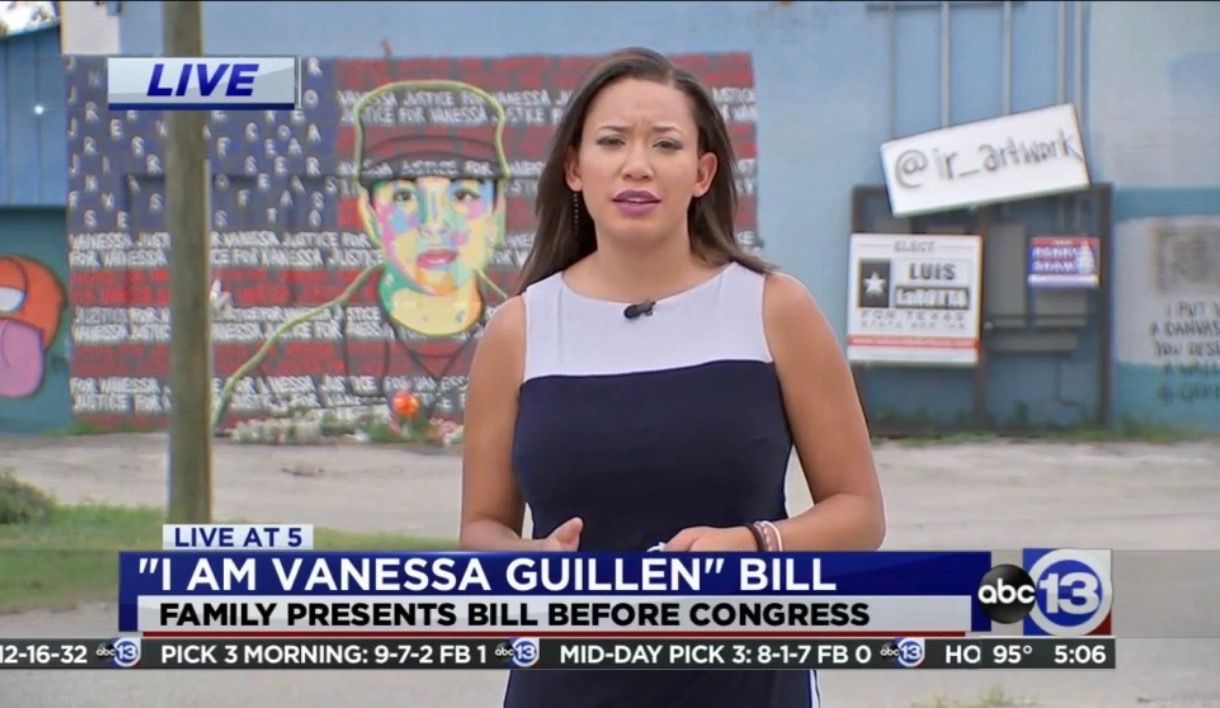I was just seven years old when my neighbor, Weather Forecaster Bill Taylor, took a few of us on a tour of the KENS 5 TV station in San Antonio, Texas. When we walked into the newsroom, the energy was electric. You could hear the internet dial-up, producers were yelling across the room, and a tall, beautiful brunette reporter dashed past us, with a mic connected to a long cable, and ran out the back door to chase the breaking news of the day. I didn’t know it then, but I know now, I chase that rushing feeling every day.
Twenty years later, I was the KENS 5 reporter running out the door with gear and script in hand, rushing to my live shot location. But even before that day, as a child, I was always drawn to stories—whether it was the ones my family told at the dinner table, my grandmother handing me the newspaper and asking me to find the editor’s mistakes, or watching breaking news headlines flashing across the screen.
That fascination with storytelling morphed into a passion for journalism, and I eventually found myself chasing headlines as a broadcast reporter for nearly a decade, ending in a top 10 market, recognized as one of the best multimedia journalists in the country, and slated to become a national correspondent. But, as with many things in life, I reached a point where that dream no longer served me the way it once had. That spark I’d been searching for in everything I did began to dim. It was time for a shift.

The transition from broadcast journalism to public relations (PR) was an unexpected but ultimately rewarding leap. I cut the cord, if you will, and went from going live multiple times a day to working from home. While it seemed like a departure from my past, it felt more like a reset than a restart. I’ve come to realize that both roles are rooted in one thing: storytelling. But in PR, I shifted from simply reporting the story to shaping the narrative—helping brands tell their own stories and gain rewarding media wins.
I hope that others navigating similar transitions—whether career-wise or in life—will find some useful insights from my story that will help their own growth.
The Transition from Broadcast to PR
The most obvious difference between broadcast and PR is the pace. Broadcast news is intense and fast-moving. The deadline is always right now. You’re reporting live, making decisions on the fly, and constantly juggling multiple stories. In contrast, PR requires strategic, long-term planning. While it may lack the urgency of the newsroom—as we like to say, “It’s PR, not the ER”—it demands an entirely different kind of thought process. You must anticipate what could come next, manage client expectations, and think steps ahead rather than just focusing on what’s happening now.
The storytelling in both fields is also different. As a reporter, I was telling the facts—what happened, when it happened, and who was involved. In PR, storytelling became much more about crafting a brand’s narrative—creating a story that connects emotionally with an audience and builds trust over time. The shift from public-facing work to working behind the scenes was another major change. Instead of standing in front of the camera, I was now working behind the scenes, creating strategies, pitching media, and collaborating with clients to make sure I captured their voice and weaved in their company’s key messaging in the best possible way.
This shift forced me to slow down and reassess how I approached my work. I had to learn the value of patience —something I still work on daily.

Transferrable Skills and Embracing New Challenges
There were many skills I carried over from my years in broadcasting: writing, communication, storytelling, pitching, crisis management, and media outreach. But there were also new skills to master.
In PR, I quickly learned the importance of client relations, and project management. I was managing multiple clients, each with unique needs and expectations, and trying to balance that with the demands of running a team. Of course, this transition wasn’t without its challenges. There were moments of imposter syndrome when I doubted whether I truly belonged in PR. Could I make the shift from telling stories on-air to creating strategies behind the scenes?
I soon realized that I wasn’t alone in this struggle. Many of my colleagues had crossed similar bridges, and I was reminded that growth often comes from the discomfort of stepping into new roles.
I also had to deal with stereotypes about the “TV vs. PR” divide. Many people still view broadcast journalism as a glamorous career and PR as less exciting. Overcoming these misconceptions was tough, but I soon realized that my experiences in the newsroom gave me a unique perspective in PR—something our clients have valued.
How PAN Culture and Training Helped Me Identify My Bad Work Habits
When I decided to pull the plug and leave the newsroom, I was physically, mentally, and spiritually exhausted. Then, not even a month later, I lost my best friend—my grandmother. I look back now and see I was drowning and had been drowning for a long time. Just constantly living in survival mode, and it was exhausting. I was losing interest in things that once gave me joy and burned out to the Nth degree. Plus, dealing with grief—for my grandmother, grief of my career in news—it was a lot.
Through PAN trainings, I learned that I had to ditch this “hustle culture”—constantly chasing deadlines and feeling like you need to be “on” all the time—and bring some balance in my life. PAN’s culture gave me the tools to break that cycle. I’ve learned to recognize when I’m reaching my limit, and I’m more comfortable (kind of) with saying “no” when I need to. I’ve also realized that asking for help isn’t a sign of weakness; it’s a critical part of maintaining your well-being.
It wasn’t easy to unlearn some of the bad habits that I feel like the newsroom enabled —like the pressure to be available 24/7 and constantly checking in—but PAN has helped me rethink these behaviors and develop healthier habits.

Lessons Learned
The biggest lesson I’ve learned throughout this journey is that personal growth and career success don’t have to be linear. The transitions we go through, whether in work or in life, are opportunities to adapt and evolve. I’ve learned to embrace the learning curve, to trust in my transferable skills, and to focus on what truly matters—setting boundaries, asking for help, and living a life worth living.
To anyone contemplating a career change or struggling with burnout, remember that your experiences, no matter how different, add value. Career progression doesn’t need to be a straight line. Embrace the process, trust in your growth, and, above all, bet on yourself. If you bet on yourself, you’re guaranteed to win whether it’s a good call or tough life lesson, walk away knowing you gave it your all. And always, always, be kind to yourself in the process.



